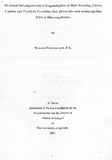| dc.description.abstract | Myoglobin (Horse heart, metMb) in bicontinuous microemulsion, prepared from
sodium dodecylsulfate (SDS) or cetyltrimethylammonium bromide (CT AB), tetradecane.
pentanol and water exhibited adsorption peaks on carbon electrodes (Glassy carbon-GC
and pyrolytic graphite-PG), whereas on Platinum (Pt) potrayed diffusion-like controlled
peaks. Electrode reduction of metMb had EO. of -0.244±0.0012V at PG/SDS,
0.200S±0.0063 V at PG/CT AB, -0.263±0.0008V at GClSDS, -0.228±0.0023 V at
GCICTAB, -0.S20±0.0049V at PtlSDS and -0.S7S±0.0098V at PtiCT AB media. The
surface concentrations of the metMb for the cathodic peaks were in the range of
1O-lomoIcm-2 at PG and 1O-12moIcm-2 at GC electrodes.
Trichloroacetic acid (TCA) and dibromocyclohexane (DBCH) were reduced in the
presence of metmyoglobin at the following potentials at rotating carbon electrodes
(RDE): -0.262±0.0 13V vs. SCE at PG/acetate buffer solution/TCA, -0.300±0.0 II V vs.
SCE at PG/SDS/DBCH, -0.330±0.0 13V vs. SCE at GC/SDS/TCA, -0.279±0.0 II V vs.
SCE at GClCTAB/DBCH. The turn over rates (kcat) for the electrocatalytic reduction of
TCA, catalyzed by metMb was 8.183±0.72 x 103S-1 in acetate buffer solution which was
higher than in both SDS (6.83±1.177 S-I at PG and "8.93±2.S64 S-I at GC electrodes) and
CTAB (9.929±0.818 S-I at PG and 9.178±0.161 S-I at GC electrodes) microemulsions. In
case of DBCH, the kcat values were higher in SDS (2.0114±0.818 S-I) microemulsion
than in acetate buffer solution (OA06±0.0032) S-I). Overall, the kcat values were higher
for the TCA reduction than DBCH reduction. The direct reduction ofTCA and DBCH in
both microemulsions on RDE occurred at -1.73V vs. SCE and -1.84V vs. SCE
respectively. But under the influence of a catalyst (metMb), there was a lowering of
overpotential of at least I.SV for both substrates.
The catalytic efficiency, kcat/Km, as determined from linearized Michaelis-Menten
equation on a linear regression program had an average of 106M-Is-I for the reduction of
TCA in acetate buffer solution, 104 M-Is-I for TCA in both SDS and CTAB
XIV
microemulsions, 10' M-'s-' for the OBCH in acetate buffer solution and 105 M-'s-' for
OBCH in SOS microemulsion at rotating carbon electrodes.
The uv-visible spectra of 3.448x 1O-6MmetMb showed bands at Amax 409nm in
both de-ionized water and acetate buffer solution and Amax 401nm and Amax 402nm in
SDS and CTAB microemulsions respectively. The hypochromiclblue shift of the soret
band of metMb in both SDS and CTAB microemulsions, compared to water and acetate
buffer solutions by about 8nm indicates that the catalyst is in a microenvironment
different from that of water a lone, pointing a finger to residency in interstitial sites
occupied by the surfactant.
Catalytic films were constructed on PG electrode by covalently binding poly-L-Iysine
(PLL) onto oxidized carbon electrodes and then forming electrostatic linkages from PLL
to the metMb through poly(styrenesulfonate)(PSS). Cyclic voltarnmetry of these films,
"[PSS/MbIn'' in SDS microemulsion showed a pair of well defined, chemically reversible
peaks at a bout -O.lS4V vs. SCE at PG electrode, characteristic of the Mb heme Fe"l/Fe"
redox couple of surface bound electrochemistry. Electroactivity of these films was
extended to 5 [PSS/Mbl bilayers. These films [PSS/MbJs in SDS microemulsions were
used to facilitate redox reactions of polar trichloroacetic acid with significant decreases in
the electrode potential required, thereby lowering the energy require to decompose the
organohalide. Moreover, there was a decrease in catalytic efficiency, ic/id,with increase
in scan rate, as expected in homogeneous solutions. | en |

